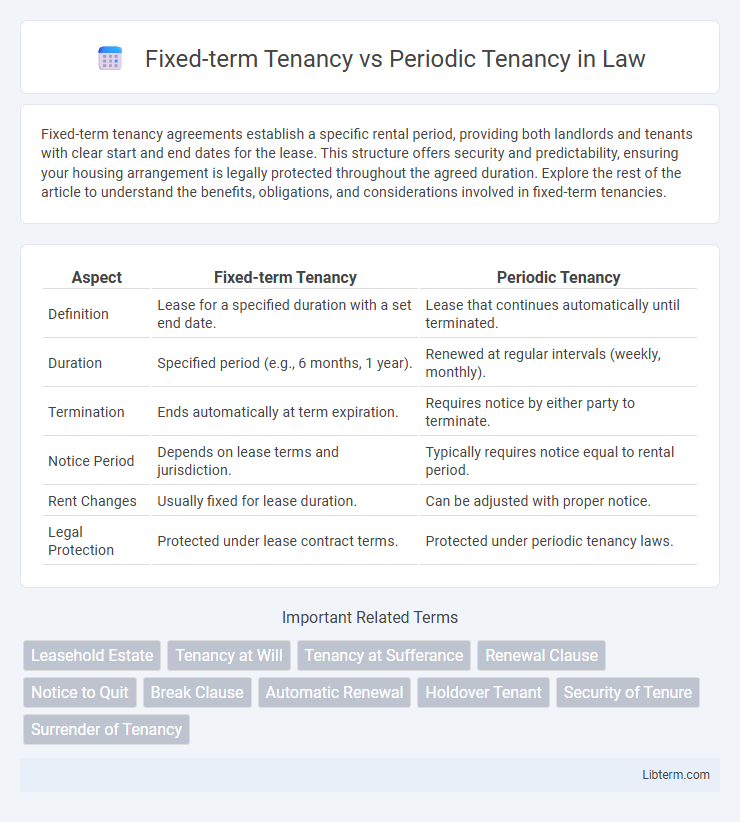Fixed-term tenancy agreements establish a specific rental period, providing both landlords and tenants with clear start and end dates for the lease. This structure offers security and predictability, ensuring your housing arrangement is legally protected throughout the agreed duration. Explore the rest of the article to understand the benefits, obligations, and considerations involved in fixed-term tenancies.
Table of Comparison
| Aspect | Fixed-term Tenancy | Periodic Tenancy |
|---|---|---|
| Definition | Lease for a specified duration with a set end date. | Lease that continues automatically until terminated. |
| Duration | Specified period (e.g., 6 months, 1 year). | Renewed at regular intervals (weekly, monthly). |
| Termination | Ends automatically at term expiration. | Requires notice by either party to terminate. |
| Notice Period | Depends on lease terms and jurisdiction. | Typically requires notice equal to rental period. |
| Rent Changes | Usually fixed for lease duration. | Can be adjusted with proper notice. |
| Legal Protection | Protected under lease contract terms. | Protected under periodic tenancy laws. |
Introduction to Residential Tenancy Types
Fixed-term tenancy specifies a lease agreement lasting for a predetermined period, commonly six or twelve months, offering both landlord and tenant stability and clear terms regarding rent and property use. Periodic tenancy, on the other hand, automatically renews at regular intervals such as monthly or weekly, providing greater flexibility but less security for both parties. Understanding these tenancy types is essential for navigating landlord-tenant rights, rent regulations, and eviction procedures in residential rental agreements.
What is a Fixed-term Tenancy?
A fixed-term tenancy is a rental agreement set for a specific duration, commonly six or twelve months, during which the tenant agrees to occupy the property. This type of tenancy provides stability for both landlord and tenant by clearly defining the lease period and conditions. Upon expiration, the tenancy either ends or transitions to a periodic tenancy, depending on the terms agreed.
What is a Periodic Tenancy?
A Periodic Tenancy is a rental agreement that automatically renews at the end of each rental period, such as weekly or monthly, without a fixed end date. This type of tenancy offers flexibility for both landlords and tenants, as either party can terminate the agreement with proper notice. Unlike Fixed-term Tenancy, which has a specific duration, Periodic Tenancy continues until one party decides to end it.
Key Differences Between Fixed-term and Periodic Tenancies
Fixed-term tenancy involves a lease agreement set for a specific duration, typically six months or one year, providing certainty for both landlord and tenant regarding rent and possession dates. Periodic tenancy continues indefinitely on a rolling basis, such as month-to-month, offering flexibility but less stability. Key differences include the fixed tenancy's definite end date versus the periodic tenancy's automatic renewal until notice is given, and varying notice periods required for termination by either party.
Advantages of Fixed-term Tenancy
Fixed-term tenancy offers tenants the security of a stable rental period, ensuring predictable housing arrangements without sudden rent increases or eviction threats during the lease term. Landlords benefit from guaranteed rental income and reduced turnover, minimizing vacancy periods and administrative costs. This arrangement facilitates long-term planning for both parties, fostering a more reliable and structured rental relationship.
Benefits of Periodic Tenancy
Periodic tenancy offers flexible rental arrangements that automatically renew at the end of each rental period, providing tenants and landlords with adaptability without the need for contract renewal. This type of tenancy enables tenants to avoid long-term commitment, making it easier to move or adjust living situations on short notice. Landlords benefit from steady income with the ability to adjust terms or rent more frequently compared to fixed-term leases.
Termination Rules: Fixed-term vs Periodic Tenancy
Fixed-term tenancy termination rules require tenants or landlords to adhere strictly to the lease expiration date, with termination typically only permitted at the end of the agreed contract unless a breach occurs. Periodic tenancy, often month-to-month, allows either party to terminate the lease by providing proper notice, usually 30 days, without needing to wait for a lease term to end. Landlords must comply with local regulations, which may impose specific notice periods or conditions for termination depending on tenancy type.
Renewal and Extension: What Tenants Should Know
Fixed-term tenancy agreements have a predetermined duration, after which tenants must either renew the lease through a new contract or vacate the property, ensuring clear terms for extension or termination. Periodic tenancies automatically continue on a rolling basis, usually monthly or weekly, allowing tenants more flexibility but requiring proper notice to end the agreement. Tenants should understand that fixed-term leases demand explicit renewal actions, while periodic tenancies renew by default unless either party provides a legally required notice to terminate.
Legal Rights and Responsibilities
Fixed-term tenancy grants tenants the right to occupy the property for a specified duration, during which landlords cannot terminate the lease without cause, ensuring stability and predictable rent obligations. Periodic tenancy, often month-to-month, offers flexible termination terms requiring proper notice from either party, but tenants may face less security compared to fixed-term leases. Both tenancy types impose legal responsibilities including maintenance duties, rent payment, and adherence to lease conditions, with statutory protections varying by jurisdiction to safeguard tenant and landlord interests.
Choosing the Right Tenancy for Your Needs
Choosing between a fixed-term tenancy and a periodic tenancy depends on your need for stability versus flexibility. Fixed-term tenancies provide a set rental period, ideal for budget planning and guaranteed occupancy, while periodic tenancies offer ongoing, month-to-month agreements suited for uncertain or short-term living situations. Evaluating your lifestyle, financial certainty, and long-term plans ensures selecting a tenancy type that aligns with your housing requirements.
Fixed-term Tenancy Infographic

 libterm.com
libterm.com